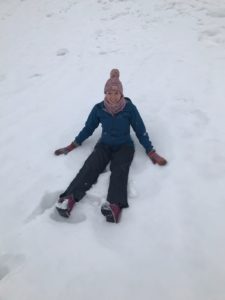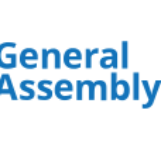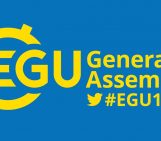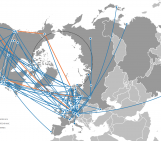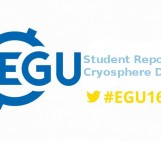The European Geophysical Union (EGU) has a number of scientific divisions or themes, such as cryosphere, atmospheric sciences and geodesy. Each division has a representative for early career scientists, and often a team of scientists who write and edit blogs and organise events. Today, Jenny Turton, the new representative for the cryo-division, explains a bit more about the role and what she hopes to achieve.
JT: Hi! I’m Jenny Turton, the new EGU CR ECS rep.
That’s a lot of acronyms, help us out?
JT: It is quite a mouthful. I am the representative for Early Career Scientists (ECS) in the cryosphere (CR) division for the European Geosciences Union (EGU).
Am I an ECS? Are you my rep?
JT: EGU says that an early career scientist is anyone who has finished their highest degree within the last 7 years (or 8 if you’ve had time away for childcare or healthcare). Although I am interested in promoting early career scientists across all physical science disciplines, I am the representative for anyone in the cryospheric sciences. That includes anyone studying/researching ice, snow, cold climates, polar regions, high-mountain glaciers, sea ice, permafrost, atmosphere-ice interactions, ice sheets… and I’m sure I have forgotten some. 56% of the cryosphere community who have an EGU membership are early career scientists!
So what will you do in your new role?
JT: I will be the point of contact between any early career scientists and EGU. I will put forward suggestions from the cryosphere community to the EGU council, on how EGU can better represent and support early career scientists. This includes at the general assembly in Vienna (mostly just known as EGU), but also in EGU journals and other events. More specifically, I have two main avenues I would like to work on during my time. Want to know more?
Yes please!
JT: Firstly, I want to support and develop the early career scientist community in terms of diversity. This includes gender, ethnicity and LGBTQ+ rights. Just 35% of the EGU members are women, and this increases to 42% for early career scientist community. Whilst the EGU cryosphere hasn’t yet analysed their breakdown in terms of gender, just 33% of the American Geosciences Union cryosphere members (our American sister) are women. The number of women in STEM areas (Science, Technology, Engineering and Maths) is increasing, but I want to do more to represent the women we already have in science, and to try and increase the numbers. When organising panel talks, or inviting guest speakers, please think about how you can ensure a more diverse range of backgrounds and routes into science. Read our past blog dedicated to women in science.
We do not have numbers of scientists who categorise themselves as LGBTQ+, however at the general assembly in Vienna in 2019, EGU held their first ‘pride’ event, which was well attended. In this event we discussed what challenges scientists have faced on their career path so far, and how ‘allies’ (people who do not categorise themselves as LGBTQ+ but want to be supporters of those who do) can assist and support in making EGU and science a more diverse place. I will be supporting the organisers of this event again for next year’s General Assembly.
That sounds like a good idea! I follow ‘Polar Pride’ (@PridePolar) on twitter. What’s your second focus point?
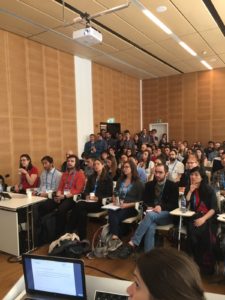
The ECS reps and cryo team organise short courses at the general assembly which are well attended and are aimed at the ECS community. Topics include: how to find funding (the picture here), a polar career panel (jointly run with APECS) and presenting tips. [Credit: Jenny Turton]
JT: My second focus is on making strong links between the other EGU early career scientist reps. I have a small confession… I am not wholly within the cryosphere division, I am actually a mixture of cryosphere, atmospheric sciences and climate. There are many scientists (especially scientists who move between topics after their PhDs) whose research does not fall into one category. I research the interactions between the atmosphere and the cryosphere for the 79°N glacier in Northeast Greenland (see this previous blog post). More specifically I have looked at whether there is evidence of climate change in this region (big hint: there is) and run an atmospheric model to investigate the processes that are having an impact on the ice. I know I am not the only person who spans multiple research divisions, but that doesn’t mean you have to feel left out, or as if you’re in no-man’s land. During my time as a rep, I aim to work closely with other reps to create bridges between them. This will include joint social activities and organised short-courses that are of interest to many groups.
You’re going to be a busy bee (or a busy polar bear maybe?). Do you do this alone?
No! Absolutely not. The EGU cryo team includes many people. We have a number of chief editors, many regular editors and authors for our weekly blogs. We have a social media team, who focus on spreading important information and highlighting our blog posts. We also rely on a number of members who help organise and convene the short courses at EGU and organise our other events. We are always looking for new members for our growing team. Get in touch for information on joining us!
How do we know you will get this done? Do you have any experience of this sort of role?
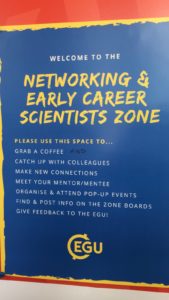
The Networking and Early Career Scientist Zone is a new feature at the EGU general assembly, and is a space for early career scientists to meet their reps, hang out, work in a quiet spot and grab a coffee. There is also an info board with all of the social and off-programme events taking place. [Credit: Jenny Turton]
JT: Actually, yes! I have always been active in outreach, organisation and extra-academia activities throughout my PhD and postdoc. I was the head of education and outreach for the UK Polar Network (the UK Branch of the Association for Polar Early Career Scientists) and have organised student conferences with the Royal Meteorological Society. I’m also pretty organised, and a big fan of to-do lists which keep me on track. I think I am quite well placed to ensure that as many scientists voices with the cryosphere are heard. I completed my PhD in 2017 with the British Antarctic Survey (there’s a lot of cryo scientists there you know) and the University of Leeds. I also keep in contact with the University of Lancaster, where I did my masters and undergraduate degrees. Now, I am based in Erlangen, with two growing teams of scientists with cryosphere interests, and my research is part of a larger German-based project with many cryo-scientists. I’m also an active tweeter (@TurtonJ1990) which means I can often reach out to other early career scientists on the twittersphere.
How can we get in touch with you and how will you give us information?
JT: The best way to contact me is through the EGU cryosphere email (ecs-cr@egu.eu), or on twitter (@TurtonJ1990 or @EGU_CR). During the next EGU general assembly (#EGU20), I will often be in the Networking and ECS lounge, or floating between cryosphere sessions (unless its 6pm, then I’ll be near the beer stand!). The cryo twitter account will inform you of social events and relevant dates for EGU, our blog will keep you informed more informally, and there are the EGU ECS newsletters.
Right, thanks for the info. I’d better get on to publishing this blog.
JT: And I need to do some research. Feel free to get in touch!
Edited by Sophie Berger

